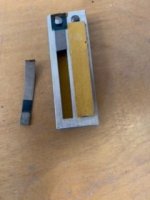Hello, all- I am in California, just received a Ambassador accordion off of ebay and I have run into an important but perplexing (for me) problem.
The accordion was in poor shape with whole reed valves banging around in the case. When I opened up the instrument I found one whole row of reed valves in the two bank base side, broken free from it's setting. All the reed valves were there- fortunately. They are all the same size but I can figure out higher and lower notes by sight and weight.
My problem is.....What order do I put them back in?
The reed valves on the good side of the bank, holding level and looking face on, has the highest tones on the right, with progressively lower tones to the left.
So, looking face on to the empty side, is the lowest tone on the left or right end?
Thank you,
Craig
The accordion was in poor shape with whole reed valves banging around in the case. When I opened up the instrument I found one whole row of reed valves in the two bank base side, broken free from it's setting. All the reed valves were there- fortunately. They are all the same size but I can figure out higher and lower notes by sight and weight.
My problem is.....What order do I put them back in?
The reed valves on the good side of the bank, holding level and looking face on, has the highest tones on the right, with progressively lower tones to the left.
So, looking face on to the empty side, is the lowest tone on the left or right end?
Thank you,
Craig

